Le test de l'audition mesure l'acuité auditive dans les oreilles droite et gauche de l'enfant afin de déceler une éventuelle perte d'audition. Les résultats vous aideront, ainsi que l'enfant et la personne qui s'occupe de lui, à décider si une aide auditive peut être utile.
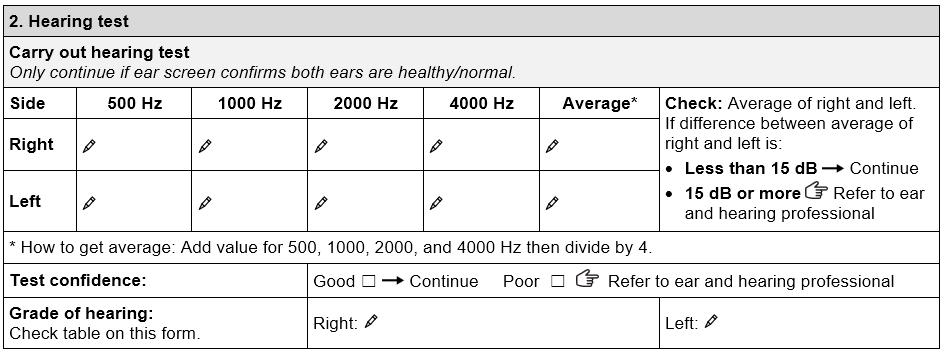
Instruction
Utilisez la section du formulaire d'évaluation relative au test de l'audition et consultez le tableau des degrés de perte d'audition pour déterminer si l'enfant présente une perte d'audition.
Question
Que pouvez-vous faire pour que l'enfant présentant une perte d'audition comprenne mieux ce que vous dites ?
Sélectionnez deux réponses.
Si vous avez sélectionné les réponses c et d, vous avez raison.
Asseyez-vous au même niveau que l'enfant. Gardez le visage bien éclairé tout en parlant clairement et lentement pour que l'enfant comprenne mieux ce que vous dites.
Une démarche adaptée aux enfants
Préparez l'enfant au test de l'audition de manière simple, ludique et amusante.
Montrez-lui le matériel afin qu'il sache comment le test de l'audition se déroulera.
Instruction
Regardez cette vidéo d'une agente de santé qui utilise une démarche adaptée aux enfants pour expliquer le test de l'audition.
Question
Regardez cette photo d'une agente de santé montrant du matériel en utilisant une démarche adaptée aux enfants.
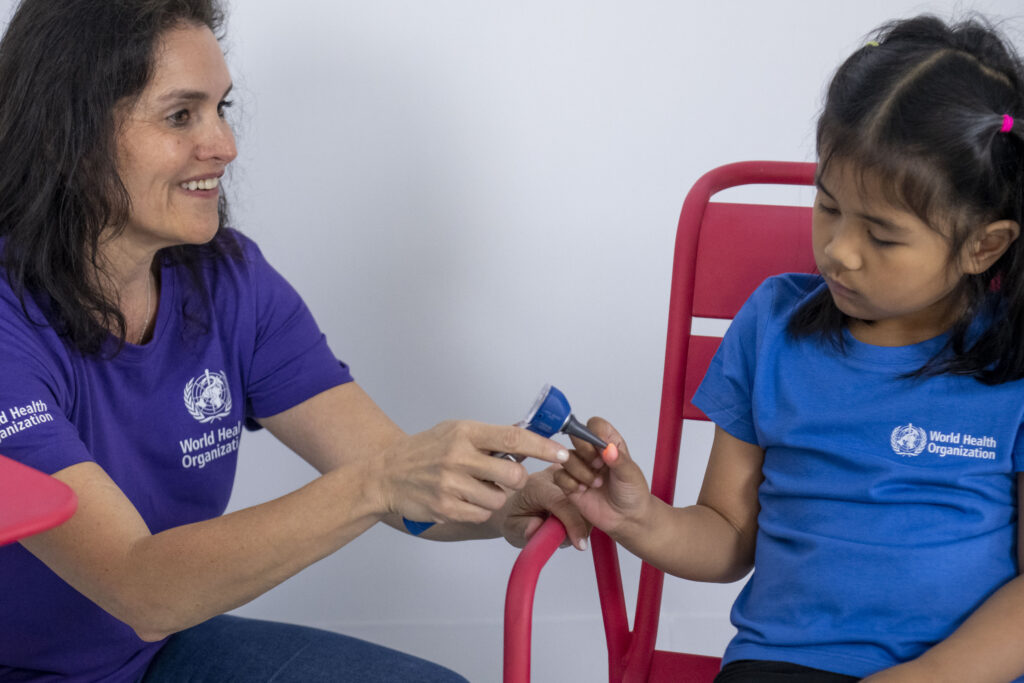
1. Qu'est-ce qui rend cette démarche adaptée aux enfants ?
- Le fait de s'asseoir au niveau de l'enfant.
- Le fait de sourire et de regarder l'enfant.
- Laisser l’enfant voir le matériel.
2. Quels sont les autres moyens de rassurer un enfant pendant un test de l'audition ?
Pour rassurer l'enfant, on peut également :
- utiliser une voix amicale ;
- expliquer les choses lentement et s'assurer que l'enfant a compris ;
- dire à l'enfant qu'il se débrouille bien.
Déroulement d'un test de l'audition
Quand vous testez l'audition d'un enfant, il faut :
- Expliquer en quoi consiste le test.
- S'exercer ensemble.
- Procéder au test de l'audition.
- Calculer le seuil d'audition moyen
- Noter le résultat pour chaque oreille.
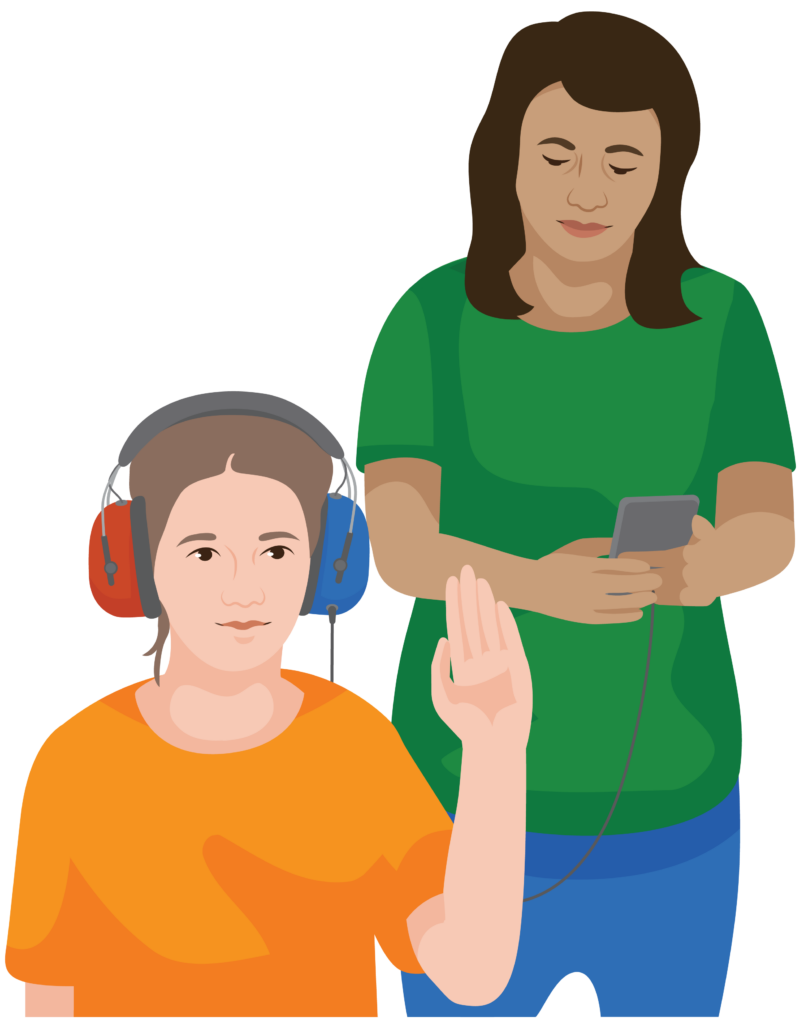
1. Expliquez le test
Expliquez à l'enfant que vous allez mesurer le son le plus faible qu'il entend (seuil d'audition) afin de tester son audition.
2. Exercez-vous ensemble
Asseyez-vous face à l'enfant pour qu'il vous voie bien.
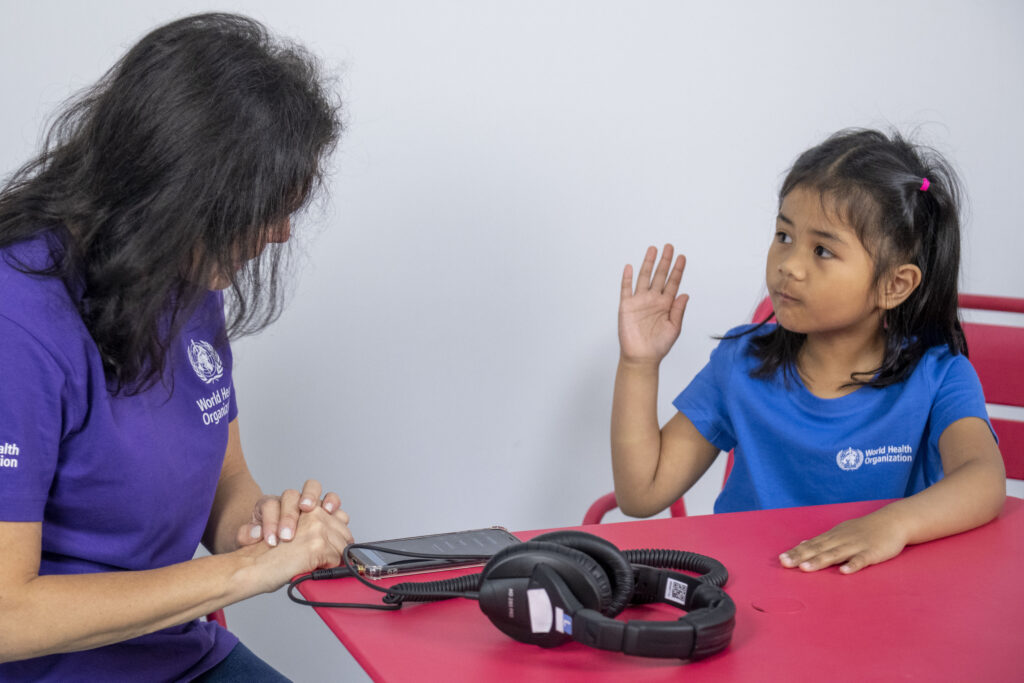
Expliquez ce qui suit :
- Dès que tu entends le son, appuie sur le bouton de réponse ou lève la main du même côté que le son.
- Relâche le bouton ou baisse la main dès que tu n'entends plus le son.
- Avant de mettre le casque, nous allons nous entraîner.
- Quand l'enfant répond, félicitez-le et encouragez-le.
Conseil
Si l'enfant ne réagit pas au test, vous pouvez essayer les solutions suivantes :
- Utiliser des jouets ou des autocollants pour encourager l'enfant à participer.
- Utiliser un autre signal de réponse, par exemple, l'enfant agite la main ou laisse tomber un jouet quand il entend le son.
- Faire une démonstration avec la personne qui accompagne l'enfant.
- Lui montrerr une vidéo d'un autre enfant faisant le test.
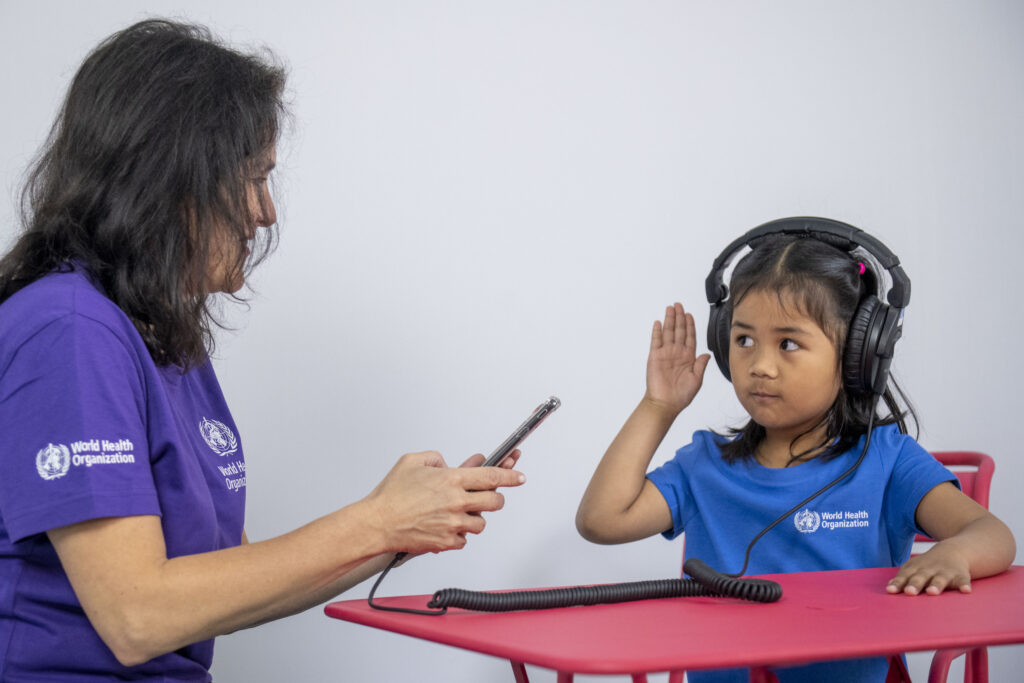
Entraînez-vous d'abord avec l'enfant à 1000 hertz (Hz) et 40 décibels (dB) :
- Demandez à l'enfant de mettre son casque à réduction de bruit.
- Assurez-vous que le casque est bien mis.
- Faites le test d'entraînement deux fois dans chaque oreille.
Conseil
Si l'enfant n'entend pas le son pendant l'entraînement, augmentez le volume de 10 dB et recommencez.
3. Procédez au test de l'audition
- Placez le casque à réduction de bruit sur les oreilles de l'enfant.
- Assurez-vous que le casque est bien mis.
- Commencez le test par l'oreille de l'enfant qui entend le mieux. Si vous le le savez pas, commencez par l'oreille droite.
- Réglez la fréquence sur 1000 Hz et l'intensité à 40 dB.
Conseil
Pour ne pas fausser le test :
- Placez-vous de façon que l'enfant ne puisse pas vous voir quand vous présentez un son.
- Changez la cadence de présentation des sons. Cela évitera à l'enfant de deviner quand vous présenterez le son suivant.
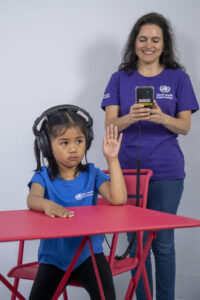
Les sons de haute fréquence, de l'ordre de 1000 Hz, sont généralement plus faciles à entendre et mettent l'enfant en confiance au début du test de l'audition.
- Appuyez sur le bouton pendant 2 à 3 secondes et voyez si l'enfant lève la main :
- Si l'enfant lève la main, réduisez le niveau d'intensité de 10 dB.
- Si l'enfant ne réagit pas, augmentez le niveau d'intensité de 5 dB.
- Continuez jusqu'au son le plus faible perçu par l'enfant :
- Émettez le son à trois reprises pour confirmer son seuil d'audition.
- Si l'enfant répond correctement au moins deux fois sur trois à la fréquence testée, notez le seuil sur le formulaire.
- Répétez le test à 2000 Hz, 4000 Hz et 500 Hz.
- Recommencez la procédure avec l'oreille gauche de l'enfant.
Instruction
Regardez cette vidéo d'une enfant qui passe un test de l'audition.
Activité
Entraînez-vous en groupes à effectuer un test de l'audition avec un enfant qui n'a pas de perte d'audition.
Préparation :
- Trouvez une salle.
- Vérifiez que le niveau sonore est adéquat à l'aide d'un sonomètre ou de l'application L'application hearWHO:
- Cliquez sur Check your hearing (Vérifier votre audition) pour accéder au sonomètre.
- Activez l'autorisation de mesurer le bruit.
Test :
- Expliquez le test d'une manière adaptée aux enfants.
- Effectuez le test à 1000, 2000, 4000 et 500 Hz sur l'oreille qui a la meilleure acuité auditive ou sur l'oreille droite de l'enfant.
- Notez le son le plus faible que l'enfant perçoit à chaque fréquence.
- Recommencez la procédure avec l'autre oreille.
Niveau de confiance dans le test
Lorsque vous effectuez un test de l'audition, réfléchissez à la confiance que vous accordez aux résultats du test.
Vous pouvez avoir confiance dans les résultats du test dans les cas suivants :
- La personne réagit aux sons de manière cohérente.
- Vous avez déterminé le seuil d'audition pour chaque fréquence.
Les résultats du test risquent de n'être pas fiables si l'enfant :
- Réagit aux sons de manière aléatoire.
- Réagit même quand aucun son n'est émis.
- Réagit uniquement quand il vous voit activer le testeur.
Si les résultats vous semblent fiables, continuez.
Si, après en avoir discuté avec votre mentor, vous n'avez pas confiance dans les résultats du test, orientez l'enfant vers un spécialiste de l'oreille et de l'audition.
Avertissement
Les résultats du test doivent être exacts pour que vous puissiez prescrire une aide auditive adaptée.
4. Calculez le seuil d'audition moyen
- Pour obtenir le seuil moyen en dB, additionnez les valeurs de seuil à 500 Hz, 1000 Hz, 2000 Hz et 4000 Hz, puis divisez la somme par quatre.
- Comparez la moyenne de seuil de l'oreille droite avec celle de l'oreille gauche :
- Si la différence est inférieure à 15 dB, Continuez.
- Si la différence est de 15 dB ou plus Orientez la personne vers un spécialiste de l'oreille et de l'audition.
Les besoins des enfants présentant une perte d'audition unilatérale (perte d'audition dans une seule oreille) ou asymétrique (écart entre les seuils moyens à droite et à gauche supérieur à 15 dB) sont plus complexes. Orientez-les vers un spécialiste de l'oreille et de l'audition.
Instruction
Répondez aux questions suivantes pour tester vos connaissances acquises dans le module TAP sur les aides auditives préprogrammées.
Question

L'exemple d'Anju
Anju a six ans et va à l'école.
Elle a été soignée pour une infection à l'oreille. Elle revient avec ses parents au centre de santé local pour faire examiner ses oreilles et passer un test de l'audition.
L'agente de santé procède à un examen des oreilles. Les deux oreilles sont en bonne santé. Elle poursuit avec un test de l'audition. Anju réagit avec assurance pendant le test.
Regardez les seuils d'audition d'Anju pour chaque fréquence.
| Côté | 500 Hz | 1000 Hz | 2000 Hz | 4000 Hz |
| Droite | 15 | 10 | 20 | 10 |
| Gauche | 10 | 10 | 15 | 15 |
1. Quel est le seuil d'audition moyen dans l'oreille droite d'Anju ?
Le seuil d'audition moyen est de 13,75 dB.
Pour obtenir la moyenne, on additionne toutes les valeurs et on divise la somme par quatre.
2. Quel est le seuil d'audition moyen dans l'oreille gauche d'Anju ?
Le seuil d'audition moyen est de 12,50 dB.
Pour obtenir la moyenne, on additionne toutes les valeurs et on divise la somme par quatre.
3. La différence d'audition entre les oreilles droite et gauche d'Anju est-elle inférieure à 15 dB ?
Sélectionnez une réponse.
Oui, c'est exact.
La différence est inférieure à 15 dB. Vous pouvez continuer.
Consultez le tableau des degrés de perte d'audition sur le formulaire d'évaluation ou ci-dessous.
| Degré | Moyenne |
| Plage d'audition normale | Moyenne inférieure à 20 dB |
| Perte d'audition légère | Moyenne de 20 à 34 dB |
| Perte d'audition modérée | Moyenne de 35 à 49 dB |
| Perte d'audition modérément sévère | Moyenne de 50 à 64 dB |
| Perte d'audition sévère | Moyenne de 65 à 79 dB |
| Perte d'audition profonde | Moyenne supérieure à 80 dB |
4. Quel est le degré de perte d'audition d'Anju dans l'oreille droite ?
Sélectionnez une réponse.
La plage d'audition est normale.
Un seuil de 13,75 dB se situe dans la plage d'audition normale.
5. Quel est le degré de perte d'audition d'Anju dans l'oreille gauche ?
Sélectionnez une réponse.
La plage d'audition est normale.
Un seuil de 12,50 dB se situe dans la plage d'audition normale.
5. Notez le résultat pour chaque oreille
- Notez les valeurs moyennes de l'audition dans la section du formulaire relative au test de l'audition.
- Notez le niveau de confiance dans le test.
- Indiquez le degré de perte d'audition de l'oreille droite et de l'oreille gauche.
Suivez la procédure recommandée pour le niveau de perte d'audition indiquée dans le tableau des degrés de perte d'audition .
Expliquez les résultats du test
Après avoir effectué le test de l'audition et déterminé le degré de perte d'audition, expliquez les résultats et indiquez à l'enfant si une aide auditive lui serait utile.
Vous souvenez-vous d'Anju ?

Vous expliquez les résultats du test de l'audition à Anju et à ses parents. L'audition d'Anju est normale. Elle n'a pas besoin d'aide auditive.